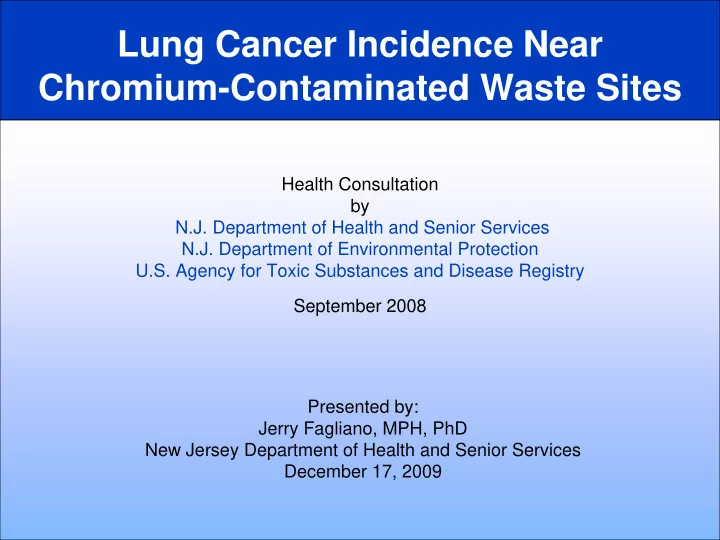

Lung Cancer Incidence Near Chromium-Contaminated Waste Sites Health Consultation by N.J. Department of Health and Senior Services N.J. Department of Environmental Protection U.S. Agency for Toxic Substances and Disease Registry September 2008 Presented by: Jerry Fagliano, MPH, PhD New Jersey Department of Health and Senior Services December 17, 2009
Purpose • Examine whether lung cancer incidence rates differ within Jersey City, by distance from chromium waste sites
Methods: Population and Cancer Case Data • Population – Jersey City residents by U.S. Census block group • Time Period – 1979—2003 (25 years) • Cancer Cases – Lung cancer cases in Jersey City from 1979—2003 – New Jersey State Cancer Registry – Assigned to U.S. Census block group based on residence at the time of diagnosis
Methods: Exposure Assessment • Mapped site boundaries • Classified sites based on chromium concentration • Drew 300 foot buffers around site boundaries • Calculated proportion of the residential area in each census block group that fell within a 300 foot buffer
Methods: Comparison of Rates • Characterized and combined census block groups into exposure categories (none, low, or high) • “High” exposure category was defined in four alternative ways • Compared lung cancer incidence rates in “high” and “low” to “none” Example (method 3)
Findings • Rates of lung cancer comparing “high” areas to “none”: – Males: 7% to 17% higher – Females: 0% to 10% higher – Chance could explain the differences • Numerous limitations to this type of investigation • Findings do not demonstrate a cause-effect relationship – Important risk factors could not be accounted for • Note: Historic potential for exposure to chromium does not represent current conditions in Jersey City
Next Step • Conducting similar analysis for other cancers: – Oral, esophagus, stomach, small intestine – 1979-2006 (28 years) • Report being drafted by NJDHSS for review by ATSDR
Recommend
More recommend